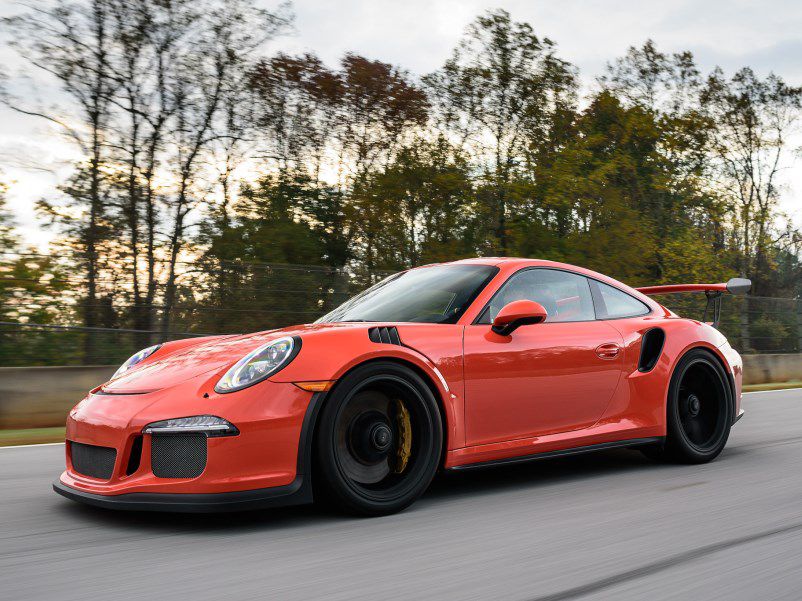Recent Articles
Popular Makes
Body Types
2016 Porsche 911 GT3 RS Test Drive

2016 Porsche 911 GT3 RS 001
A glance at the digital speedometer in the 2016 Porsche 911 GT3 RS indicates that I am rocketing down Road Atlanta’s back straight at 137 mph. That’s not normally an eye-opener — it’s a long straight and the coupe is capable of 193 mph — except that I am driving the GT3 RS at triple-digit speeds in a torrential downpour.
Grip and outward vision are severely challenged. My mind’s focus is blurred by the deafening clamor of water thunderously pummeling the inside of each fender, by the wail of a 510-horsepower flat-6 spinning toward redline, and by the boom of the wiper blade smacking the A-pillar with each swift yet futile swoop…
Track-Focused
Road Atlanta, located less than an hour’s drive from Georgia’s capital, is a challenging 2.3-mile racing circuit that holds a special place in Porsche’s heart — its most recent win was the Petit Le Mans race in July. The track also is a short jaunt from the company’s new North American headquarters, so it made perfect sense for Porsche to invite a handful of journalists to the venue to drive its most track-capable production model, the 2016 911 GT3 RS.
Slotted near the top of the comprehensive 911 lineup — the 911 Turbo is technically the flagship model — the GT3 RS is a raw, lightweight, high-performance derivative of the GT3 series. Consider it as track-focused as a street-legal car can be.
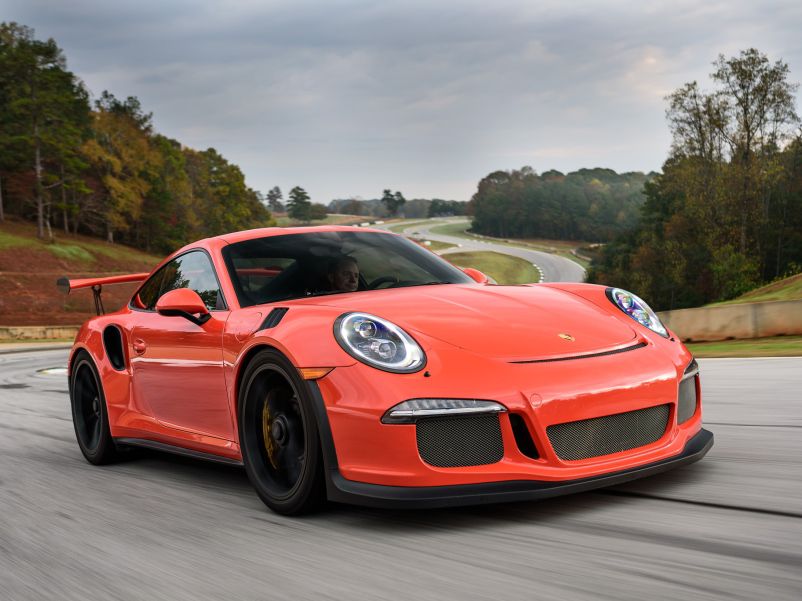
Unmistakable Exterior
The two-seater boasts the unmistakable wide-body flares, and big track, of the 911 Turbo — the front fenders are vented to dump air out of the wheel wells to improve downforce and cooling — and a massive rear wing. The front and rear fascia’s have been modified to allow even more cooling to the brakes and radiators. Its sculpted skin is a mix of carbon-fiber and lightweight alloys. To reduce mass and lower the center of gravity, Porsche manufactured the RS roof out of a thin sheet of magnesium, which is even lighter than resin-coated carbon-fiber, says the project manager. The GT3 RS tips the scales at just 3,150 pounds (the Chevrolet Corvette Z06 is nearly 375 pounds heavier).
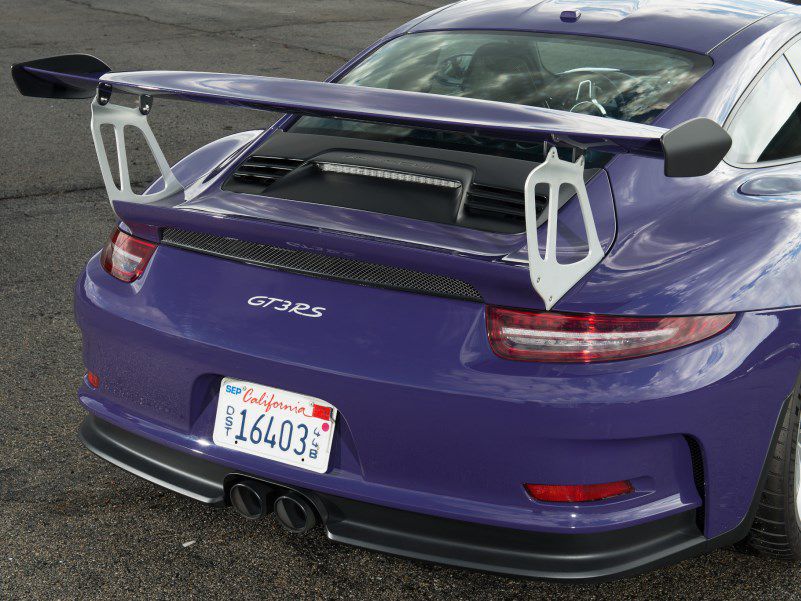
500-Horsepower Engine
Porsche fits a variety of flat-6 engines to the 911 platform and reserves the most powerful, a naturally aspirated 4.0-liter, for the GT3 RS. The 500-horsepower all-aluminum engine screams to an astonishing 8800-rpm redline, all the while sounding like it is breaking every noise ordinance in the land. Auditory bliss. Porsche mates a single transmission to the engine, the company’s celebrated 7-speed dual-clutch PDK gearbox — much faster than any manual gearbox — running software tuned specifically to the vehicle’s no-compromise mission.
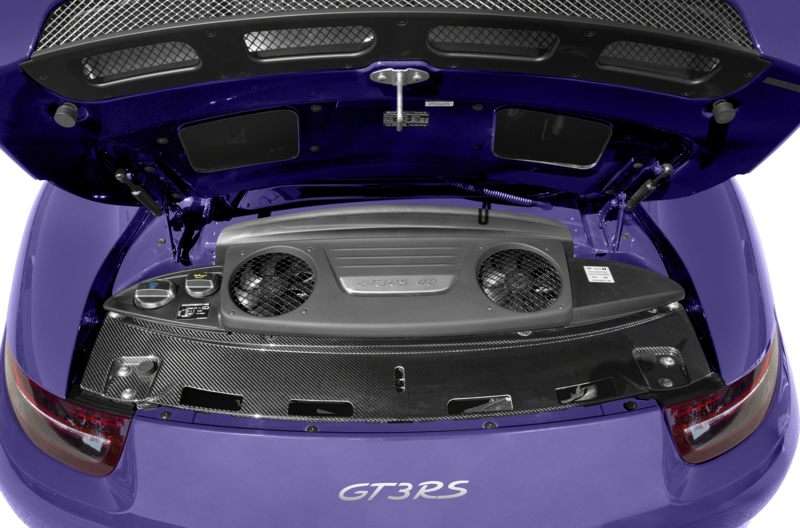
Staggered Wheels
Reduced mass and a powerful engine aren’t the only tricks the RS has up its sleeve. Aggressive aerodynamics reduce lift and improve downforce, and the wheel/tire package has been upgraded from standard 20-inchers to a staggered fitment of 20-inch wheels up front (wrapped in 265/35-20 tires) and 21-inch in the rear (wearing 325/30-21 rubber). Interestingly enough, the wider rear tires are larger diameter than those on the standard GT3, meaning the GT3 RS sits nearly an inch taller than its sibling.
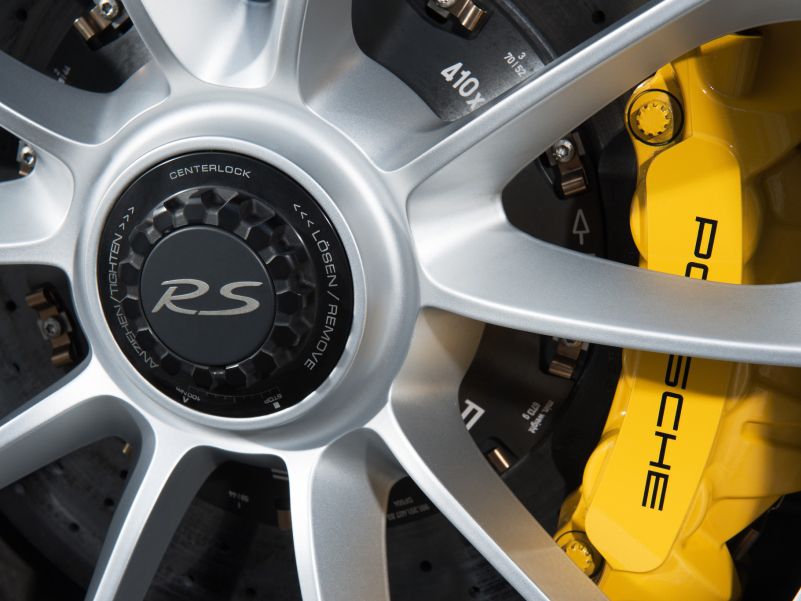
Mother Nature Strikes
Given the proper conditions, the rear-wheel-drive GT3 RS will rocket to 60 mph from a standstill in less than four seconds. But Mother Nature isn’t being cooperative today at Road Atlanta. Instead of gracing us with a beautiful autumn day, she has unleashed inches of rain, and now newborn rivers run down the apexes and the brake markers are just a blur through the continuous mist.
To help orient those drivers unfamiliar with the circuit, show the proper racing line, and offer guidance for the slippery conditions, Porsche brought along David Donohue — past winner of the 24 Hours of Daytona endurance race — to pilot the lead car in a parade of three GT3s. My nerves popping as fast as the wipers, I twist the traditional left-mounted key and the flat-6 roars to life.
Most modern cars idle with the smoothness of a purring kitten. Most automakers seek to make their engines devoid of noise, vibration or harshness. Not Porsche, and particularly not with the GT3 RS. Its 4.0 booms to life with a furious roar, and even when settled down to idle sounds temperamental, an erratic beast barely leashed.
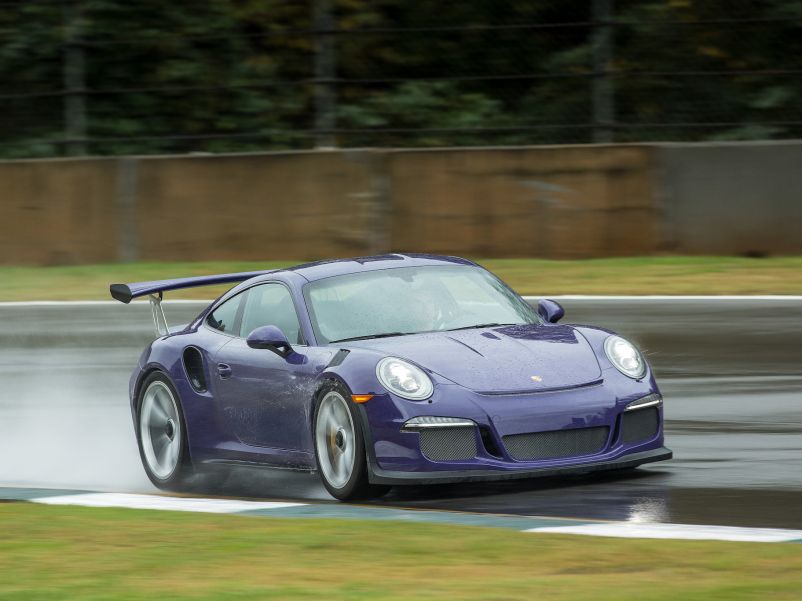
Rain at Road Atlanta
The rain is incessant. I see curtains of gray and little else in the hot pits. Despite the abysmal weather, Donohue seems undeterred. His voice cracks over the radio, “Follow me, and try to stay on my line as my tires will clear a channel on the track.” The bright red LED brake lamps on Donohue’s slate gray 911 Turbo S extinguish as he pulls away. Resolved to stay on his tail, I depress the “Sport Plus” button to enhance throttle, gearbox and stability control settings, and stab the accelerator. Both rear wheels immediately break free and the vehicle’s rear end squirms to the right — the Porsche barely moves. My right foot instinctively lifts off the throttle. This is going to be a bigger challenge than I had expected.
Thirty seconds later I’m a good 50 feet behind Donohue’s tail, running at about 65 mph, squinting through the front glass to just make out his car’s illuminated rear end through the blinding rooster tail of water thrown up by his rear tires. I’m jittery, tensely twitching on and off the throttle, wrestling the steering wheel left and right as I feel the tires slip and hydroplane. Then something unexpected happens — Donohue dramatically increases his speed.
“You need to find the grip,” Donahue says over the radio. “Very smooth inputs on steering, braking, and throttle.” He’s right. If I jerk the steering wheel and expect the razor-sharp handling of a GT3 RS in the dry, the front end skips a couple feet off the line. If I transition from throttle to brake quickly while tossing the lightweight coupe into a corner, the ABS kicks in violently. And if I stomp on the throttle wanting instant power, the rear end sways wildly. Guided by Donohue’s words and his smoothness around the track, I initiate a gentler regime of inputs through the primary controls and am instantly rewarded with adhesion that I didn’t know existed in the rain. The Porsche sticks to the race line — and Donohue goes even faster.
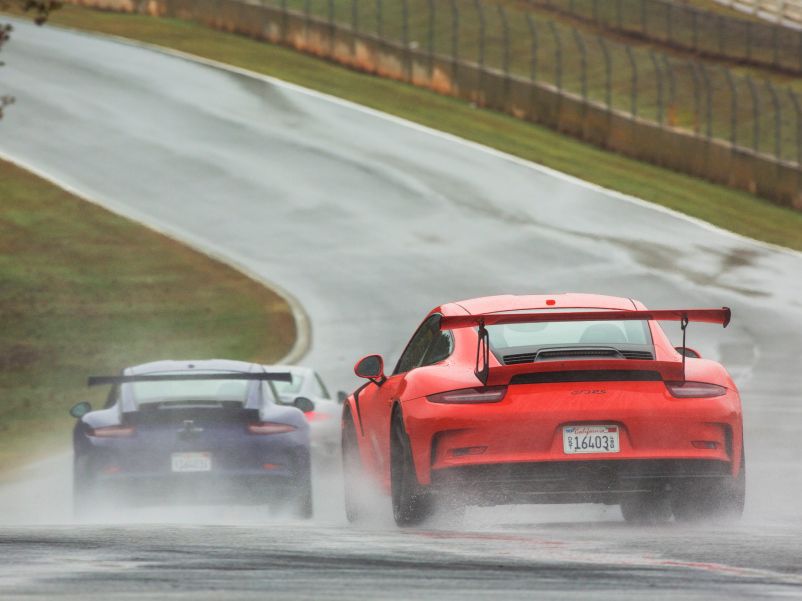
Lessons on Car Control
Compared to the 2015 GT3 RS, the 2016 model is unchanged — with one big exception. Last year’s car rolled on Michelin Pilot Sport Cup 2 tires with Porsche’s “N0” designation, while this year’s model is upgraded to next-generation “N1” status. Porsche tests show that the new tires offer substantially more grip in the dry and, despite their large and mostly continuous tread blocks, perform better than the outgoing rubber in the wet.
Within 15 minutes, my speed has doubled and I am getting in synch with the GT3 RS’s enhanced Porsche Stability Management (PSM) system, which includes anti-lock brakes, Electronic Stability Control (ESC) and Traction Control (TC). I am still nervous as hell — driving almost blind on a slick surface is never comforting — but the car is finding grip and slipping less with each subsequent lap. Soon, I am almost comfortable keeping up with Donohue’s triple-digit speeds.
This is turning out to be one of the most educational days that I have ever had on a racing circuit. Through blinding rain, I am piloting a 500-horsepower Porsche GT3 RS around the track at implausibly swift speeds — and learning a lifetime’s lesson on car control.
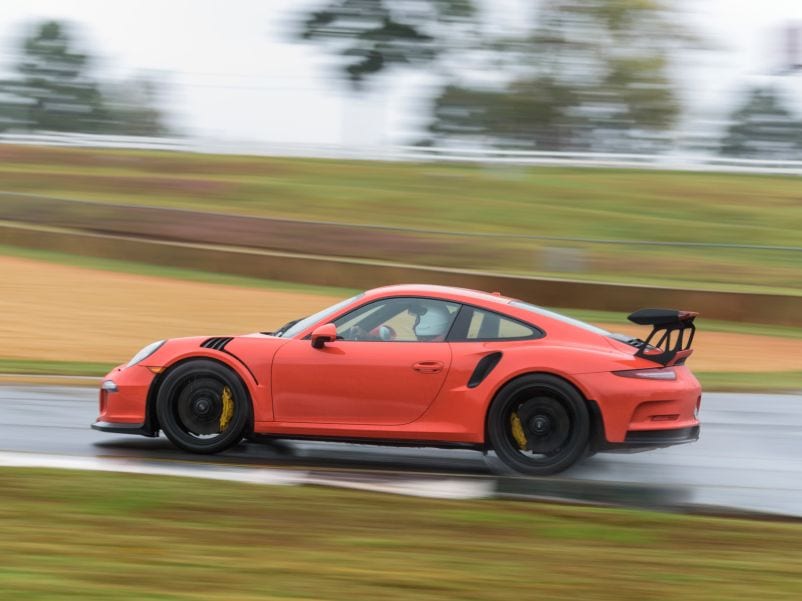
Performance Driving in the Wet
Performance driving in the wet takes an immense amount of mental concentration, but it also requires feedback — this is where the Porsche GT3 RS excels. Guiding the coupe over each slick crest, around every slippery corner, and down both of the wet straights, I am able to feel the grip come and go through one of the best steering systems even fit to a road car. And, my derriere can sense the rear wheels breaking free each time they hydroplane — gentle countersteer is all that it takes to nudge the formidable coupe back on line. There is a thin film of lubricating water between the tires and road, but the GT3 RS is returning feedback as if driving over braille dots. I am challenged to name another vehicle as connected to the road surface as this car.
Delicately guiding a high-performance sports car around a slippery rain-slickened race circuit is an awful way to evaluate at-the-limit driving dynamics — nobody is coming close to the lateral-G capabilities of the vehicle — but there is much more to be learned on a track than can be gleaned from maximum g-forces and blistering top speeds, much more to be gained than just faster lap times. A low-friction surface magnifies weaknesses and exposes flaws that would typically be masked on a dry surface — in a nutshell, a vehicle that can dance like Fred Astaire when there is no grip is probably damn spectacular at the limit under normal conditions.
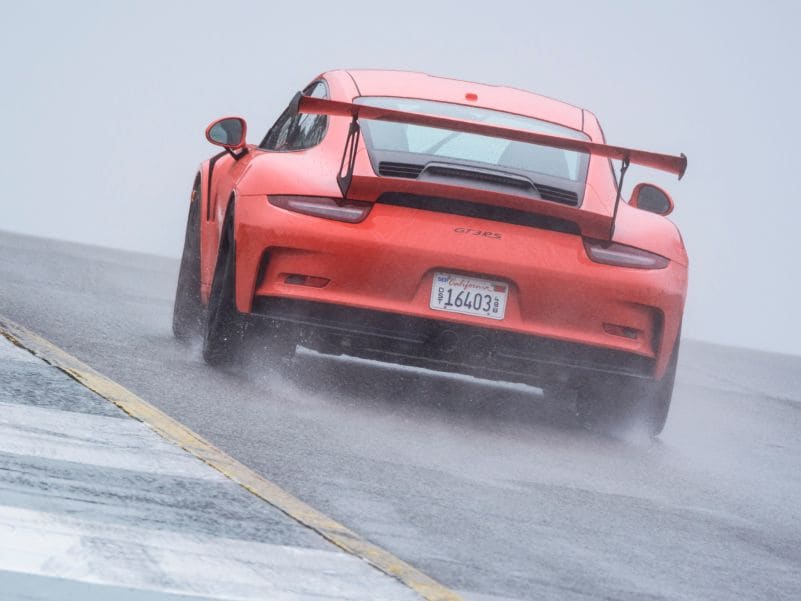
Polished Combination of Finesse, Balance, and Precision
I’ve been very fortunate to have spent time with the 2015 Porsche 911 GT3 RS on a dry racing circuit (with last-generation Michelins), so a day lapping soggy Road Atlanta was a complementary experience that revealed another side of the 500-horsepower coupe — gracefulness, a polished combination of finesse, balance, and precision.
Many automakers, including more than a handful of aftermarket companies, offer powerful sports cars that rocket to 60 mph in a few blinks and turn blistering laps in the dry. But toss those keys to an amateur, and point them towards a rain-soaked circuit, and most will be leaving the race line facing the wrong direction — heading home with muddy shoes. Despite its pit bull appearance, the GT3 RS’ is specially endowed to be ferocious in the dry and yet maintain impeccable composure when conditions deteriorate.
